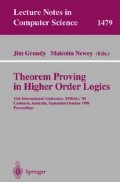Abstract
We define the syntax of unsorted first order logic as a HOL datatype and define the semantics of terms and formulas, and hence notions such as validity and satisfiability. We prove formally in HOL some elementary metatheorems such as Compactness, Löwenheim-Skolem and Uniformity, via canonical term models. The proofs are based on those in Kreisel and Krivine's book on model theory, but the HOL formalization raises several interesting issues. Because of the limited nature of type quantification in HOL, many of the theorems are awkward to state or prove in their standard form. Moreover, simple and elegant though the proofs seem, there are surprising difficulties formalizing Skolemization, one of the more intuitively obvious parts. On the other hand, we significantly improve on the original textbook versions of the arguments, proving two of the main theorems together rather than by separate arguments.
Preview
Unable to display preview. Download preview PDF.
References
N. G. de Bruijn. Lambda calculus notation with nameless dummies, a tool for automatic formula manipulation, with application to the Church-Rosser theorem. Indagationes Mathematicae, 34, 381–392, 1972.
H. B. Enderton. A Mathematical Introduction to Logic. Academic Press, 1972.
A. D. Gordon and T. Melham. Five axioms of alpha-conversion. In J. von Wright, J. Grundy, and J. Harrison (eds.), Theorem Proving in Higher Order Logics: 9th International Conference, TPHOLs'96, Volume 1125 of Lecture Notes in Computer Science, Turku, Finland, pp. 173–190. Springer-Verlag, 1996.
M. J. C. Gordon and T. F. Melham. Introduction to HOL: A theorem proving environment for higher order logic. Cambridge University Press, 1993.
P. T. Johnstone. Notes on Logic and Set Theory. Cambridge University Press, 1987.
G. Kreisel and J.-L. Krivine. Elements of mathematical logic: model theory (Revised second ed.). Studies in Logic and the Foundations of Mathematics. North-Holland, 1971. First edition 1967. Translation of the French ‘Eléments de logique mathématique, théorie des modeles’ published by Dunod, Paris in 1964.
T. F. Melham. The HOL logic extended with quantification over type variables. In L. J. M. Claesen. and M. J. C. Gordon. (eds.), Proceedings of the IFIP TC10/WG10.2 International Workshop on Higher Order Logic Theorem Proving and its Applications, Volume A-20 of IFIP Transactions A: Computer Science and Technology, IMEC, Leuven, Belgium, pp. 3–18. North-Holland, 1992.
H. Persson. Constructive Completeness of Intuitionistic Predicate Logic: A Formalisation in Type Theory. Licentiate thesis, Department of Computing Science, Chalmers University of Technology and University of Göteborg, Sweden, 1996.
R. Pollack. The theory of LEGO: A Proof Checker for the Extended Calculus of Constructions. Ph. D. thesis, University of Edinburgh, 1994.
D. Prawitz. Natural deduction; a proof-theoretical study, Volume 3 of Stockholm Studies in Philosophy. Almqvist and Wiksells, 1965.
P. Rudnicki. An overview of the MIZAR project, 1992. Available by anonymous FTP from menaik.cs.ualberta.ca as pub/Mizar/Mizar_Over.tar.Z.
S. Shapiro. Foundations without Foundationalism: A case for second-order logic. Number 17 in Oxford Logic Guides. Clarendon Press, 1991.
A. Stoughton. Substitution revisited. Theoretical Computer Science, 17, 317–325, 1988.
A. Trybulec. The Mizar-QC/6000 logic information language. ALLC Bulletin (Association for Literary and Linguistic Computing), 6, 136–140, 1978.
Author information
Authors and Affiliations
Editor information
Rights and permissions
Copyright information
© 1998 Springer-Verlag Berlin Heidelberg
About this paper
Cite this paper
Harrison, J. (1998). Formalizing basic first order model theory. In: Grundy, J., Newey, M. (eds) Theorem Proving in Higher Order Logics. TPHOLs 1998. Lecture Notes in Computer Science, vol 1479. Springer, Berlin, Heidelberg. https://doi.org/10.1007/BFb0055135
Download citation
DOI: https://doi.org/10.1007/BFb0055135
Published:
Publisher Name: Springer, Berlin, Heidelberg
Print ISBN: 978-3-540-64987-8
Online ISBN: 978-3-540-49801-8
eBook Packages: Springer Book Archive

